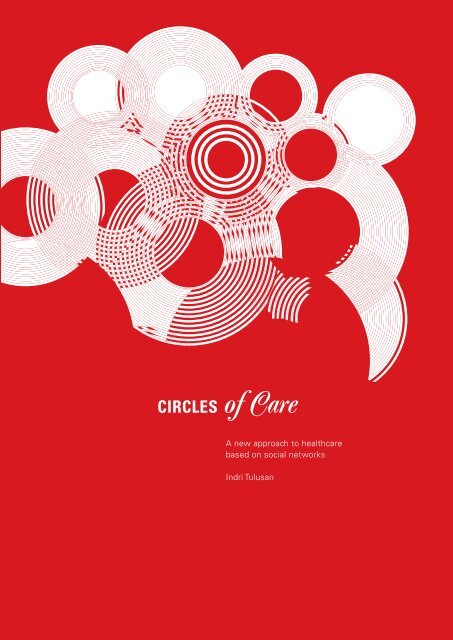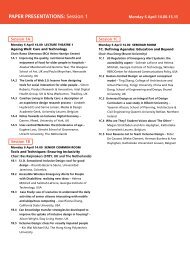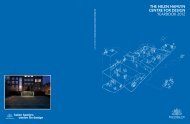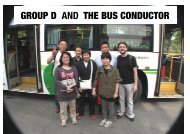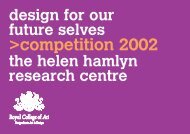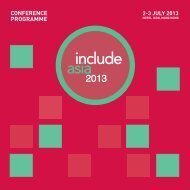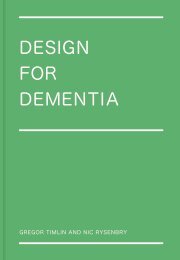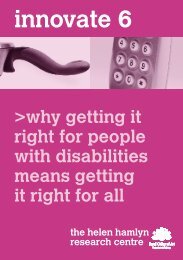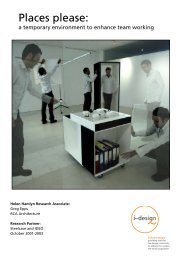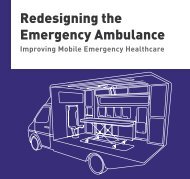CIRCLES of Care - Helen Hamlyn Centre - Royal College of Art
CIRCLES of Care - Helen Hamlyn Centre - Royal College of Art
CIRCLES of Care - Helen Hamlyn Centre - Royal College of Art
- No tags were found...
Create successful ePaper yourself
Turn your PDF publications into a flip-book with our unique Google optimized e-Paper software.
<strong>CIRCLES</strong> <strong>of</strong> <strong>Care</strong>A new approach to healthcarebased on social networksIndri Tulusan
<strong>CIRCLES</strong> <strong>of</strong> <strong>Care</strong>A new approach to healthcarebased on social networksIndri Tulusan
ContentsResearch partners 4About the author 5Executive summary 7IIntroduction 11Cure or prevent?How are you?Designing for social networksIIResearch 14Research mapDesign ethnographyResearch toolsIVThe Circles <strong>of</strong> <strong>Care</strong> space 24RelatednessLife eventsActivatorsIIIDraw yours 22VMap <strong>of</strong> the Circles <strong>of</strong> <strong>Care</strong> 32VIHealth as a social activity 34Who will play a role ?VIIService narratives 38Case studiesService narrativesVIIIConclusion: where next? 48Bibliography 50Acknowledgments 51
4°5Research partners Research partners Research partners Research partners Research partners Research partners Research partners Research partners Research partners Research partnersResearch partnersThe research project is a collaborationbetween the <strong>Helen</strong> <strong>Hamlyn</strong> Research<strong>Centre</strong> at the <strong>Royal</strong> <strong>College</strong> <strong>of</strong> <strong>Art</strong> andtwo industry partners, healthcare productdesigners Pearson Matthews and mobilenetwork company Orange.The <strong>Helen</strong> <strong>Hamlyn</strong> Research <strong>Centre</strong> wasset up at the <strong>Royal</strong> <strong>College</strong> <strong>of</strong> <strong>Art</strong> in January1999 to alert design and business to thefar-reaching implications <strong>of</strong> a rapidlychanging society. It works to advance asocially inclusive approach to designthrough practical research and projectswith industry. Its Research AssociatesProgramme teams new RCA graduateswith industry partners. www.hhrc.rca.ac.ukPearson Matthews is a design consultancythat for many years has focused on healthcare,believing that design has a great dealto <strong>of</strong>fer when used to make connectionsbetween individual, commercial and socialneeds. Their strategic futures thinking ismatched by their proven ability to deliver –taking research and developing it through toground-breaking products. www.pmuk.comThe Orange group is one <strong>of</strong> the world’slargest mobile communications companiesand a subsidiary <strong>of</strong> the France Telecomgroup, with operations in 19 countriesacross Europe and beyond. It provides abroad range <strong>of</strong> personal communicationsservices, including Orange GSM1800services and other digital cellular telephoneservices. www.orange.com
About the authorIndri Tulusan is the daughter <strong>of</strong> two doctorsand has always been fascinated by how thebody works. She initially studied medicinein Germany, where she grew up, beforetaking up product and furniture design atKingston University. Understanding patientcontact and dealing with basic humanneeds proved an excellent foundation forher under-standing <strong>of</strong> human behaviourand her subsequent interest in interactionand experience design for well-being.In 2001 Indri graduated from the <strong>Royal</strong><strong>College</strong> <strong>of</strong> <strong>Art</strong> with an MA in ProductDesign. Her final project about a mobiletechnology service (entitled >olu)won the <strong>College</strong>-wide Lattice Award forSustainability. During her studies, Indri’sproject IntelliSkin (developed with KellySant), wearable biomedical screeners, wonthe Kenny Yip medical innovation award andreceived sponsorship from Orange.Indri has worked in design research formajor companies such as Philips and Nokia.She is also active in international researchconferences such as Doors <strong>of</strong> Perception inBangalore, where she presented a projecttitled Wandervogel, developed at the <strong>Helen</strong><strong>Hamlyn</strong> Research <strong>Centre</strong> with researchpartner Cityspace.Her work with her design practice Teko hasreceived national recognition from NESTAand D&AD, and she has just completed asecond <strong>Helen</strong> <strong>Hamlyn</strong> Research Associateproject with Pearson Matthews and Orange.This book is the outcome <strong>of</strong> that study.
6°7
Executive summaryThe Circles <strong>of</strong> <strong>Care</strong> project began with thequestion: what role can communication andself-monitoring technologies play in helpingpeople maintain a proactive approach totheir health and well-being?The study was set in the context <strong>of</strong> westerneconomies struggling with escalatinghealthcare costs and growing calls for aparadigm shift – from a system that simplytreats ill patients to a model for healthservices in which the focus is on preventionrather than cure.The study took an experience designresearch approach to investigate, first, whatneeds people have in maintaining theirhealth. It compared different health modelsto analyse how they give the patient apassive or an active role.Using design ethnographic techniques, theproject conducted a cross-cultural analysis<strong>of</strong> individual attitudes to maintaining healthby focusing on a user group <strong>of</strong> 20 people(ten in the UK, ten in India and Italy) whohave recently moved to a new town orcountry. Displacement was used as thecommon element. This enabled people t<strong>of</strong>ocus on the relationships that support theirhealth beyond self-reliance.The findings <strong>of</strong> this research revealed thatpeople have three universal requirementsto support their own health: fitness <strong>of</strong>body, autonomy <strong>of</strong> mind and relatednessto others. The value <strong>of</strong> relatedness (beingsupported by a social network) and the
8°9need for trust were more apparent in India,but were also strong factors in the personalexperiences <strong>of</strong> other nationalities.From the research findings, the studyestablished the proposition that, there is an‘inbetween’ space between self help andthe expert help <strong>of</strong> medical pr<strong>of</strong>essionalsthat has received relatively little attentionfrom designers, manufacturers, service orsocial providers.This is the social network <strong>of</strong> friends,family, work colleagues and neighbourhoodfacilities such as health food shops andfitness centres which operates alongsidethe GP or hospital pr<strong>of</strong>essionals in helpingus to maintain our health. The projecthas identified the social network as acomplementary healthcare model and givenit a name: Circles <strong>of</strong> <strong>Care</strong>.The outcome <strong>of</strong> the project is a map <strong>of</strong>the space inbetween self help and expertmedical help, which shows how we build,adapt, share and pass on our personalhealth network. It is a way <strong>of</strong> thinkingabout healthcare as a social activity as wellas a the medical one. How these needsare changing is illustrated in different lifestages.This publication explores the opportunities<strong>of</strong>fered by Circles <strong>of</strong> <strong>Care</strong>. It outlines theconcept and defines its players, activators,experiences and emerging user needs.It identifies an area for development andindicates how networked technologies canactivate solutions within it. It demonstratesthe potential <strong>of</strong> approaching the shift inhealthcare from an experience designviewpoint.The outcomes are presented as a servicelandscape. Within this framework keylife stages are mapped against healthneeds and opportunities for developingsocial networks to address them. This issupported by scenarios – eight narrativesare illustrated in this report – suggestinghow this landscape can be mined for newservice opportunities linking private, publicand voluntary sector organisations in newpartnerships.BenefitsIndividuals already create their own wellbeingstrategies with the help <strong>of</strong> family,friends and work colleagues before going tothe doctor. This model <strong>of</strong>fers the possibility<strong>of</strong> support platforms to encourage thesesocial health networks.For network providers, the model canbe used to develop services which arecloser to the consumer at key life stages.The social value <strong>of</strong> these services willbuild brand loyalty by fostering a sense <strong>of</strong>partnership between service provider andcustomer at key points in the life course.For retailers and medical product companieswho make up the supply chain, there arebusiness opportunities in understandingand meeting the needs <strong>of</strong> consumers whoare responding more proactively to their
Executive summary Executive summary Executive summary Executive summary Executive summary Executive summary Executive summary Executive summary Executive summary Executive summaryown health needs. Circles <strong>of</strong> <strong>Care</strong> impliesa move beyond self-monitoring and selfdiagnosisproducts, which has grown rapidlyin recent years.For voluntary sector organisations, theopportunity to build a partnership with anetwork provider as part <strong>of</strong> a social networkcan extend their role from fund raiser toservice enabler.For the NHS, the study shows how growingnew social models <strong>of</strong> well-being couldbecome an important adjunct to the existingsystem.A beginningNew service concepts support a socialnetwork <strong>of</strong> care at different life stages.These will emerge by exploring thelandscape in more detail with the differentplayers who could enable them.The Circles <strong>of</strong> <strong>Care</strong> concept approacheshealth as a social activity and marks thebeginning <strong>of</strong> a healthcare system based onsocial networks in which individuals take anactive role in their health and the well-being<strong>of</strong> those close to them.The service narratives aim to createconversations about the opportunitiesfor all the different public, private andvoluntary sector players. In this contextthe designer can take the role <strong>of</strong> mediatorbetween the players, making all aware <strong>of</strong>evolving user needs.
10°11
IntroductionCure or prevent?The crisis <strong>of</strong> healthcare systems is anongoing issue, especially in Europeanwelfare states. In the UK we currently havea system where we wait for people to getill before we treat them. The British healthmodel is still based on cure, by destroyingthe sickening force. The ideal patient followsthe expert’s instructions without dispute.This is similar to a child’s health being thefull responsibility <strong>of</strong> its parents.However, people are now becoming moreresponsible for maintaining and monitoringtheir own bodies. Hence the growingmovement towards self-care and personalwell-being. Increasingly we look to socialnetworks <strong>of</strong> support before going to thetraditional expert system. But this socialnetwork currently receives little attentionfrom design and industry.How are you?As individuals, we are becomingincreasingly proactive with regard to ourown health. How can products and servicesaddress this?Developments in information technologycan give individuals more opportunities toinform themselves about health issues.The use <strong>of</strong> internet, mobile technologies,self-test biomedical products and genetictests are just a few examples <strong>of</strong> newtechnologies that can help individuals create
12°13Introduction Introduction Introduction Introduction Introduction Introduction Introduction Introduction Introduction Introduction Introduction Introduction Introduction Introduction Introductionand sustain their own personal healthcarenetworks."According to recent studies, 52 millionAmericans, or 55 per cent <strong>of</strong> those withinternet access, use the internet for healthand medical information. Half <strong>of</strong> thesepeople say the information they garner onthe web has improved the way they takecare <strong>of</strong> themselves, and 36 per cent say ithas affected their decision on behalf <strong>of</strong> aloved one." (Zub<strong>of</strong>f S, 2004)These trends suggest that people want tolive their lives more proactively, particularlywhere health is concerned.Designing for social networksWhen looking at new markets, oneimportant challenge is to consider thelong-term effects on behaviour and thedifferent service opportunities thatmight evolve as a result.The designer's role is to consider thislong-term relationship between users andservices and bring it to the attention <strong>of</strong> thevarious parties involved (such as business,public sector and the general public).For that reason, the research approach issited in the field <strong>of</strong> experience design andservice design. Experience design dealswith how products are experienced overtime. Service design deals with how theseexperiences are organised within networks.
These trends suggest that people wantto live their lives more proactively, particularlywhere health is concerned. >New, proactive health consumers neednew platforms to support them. How doesthis research investigate these new socialnetworks?First, it investigates the differentstrategies and experiences <strong>of</strong> usersbuilding their own social networks <strong>of</strong>health, and sets out the concept <strong>of</strong>Circles <strong>of</strong> <strong>Care</strong> to identify these strategiesand experiences. Second, it proposesa complimentary healthcare model orlandscape where user strategies andexperiences can be supported, for instanceby emerging technologies. The concept<strong>of</strong> Service Narratives is used to envisionthis new health landscape. Circles <strong>of</strong> <strong>Care</strong>and the Service Narratives within, providethe framework for designing for socialnetworks <strong>of</strong> health.In this project design is used as a researchtool - as a way <strong>of</strong> creating awareness<strong>of</strong> new social trends, and as a way <strong>of</strong>answering questions about technology,how we perceive it and how we can benefit.
14°15ResearchThe research mapFour different areas were explored toinvestigate the proactive health consumer:Current health modelsPeople inspired designCommunication technologiesCross-culture inspired designCurrent health modelsThese were examined by comparing thewestern health model <strong>of</strong> cure (responsive)and the eastern health model <strong>of</strong> care(proactive). For example, the Indian orChinese model is based on prevention bystrengthening the vitalising forces. Thedoctor serves the patient and the patientis active and instrumental in his or her ownhealth. In most western health systems,the medics are waiting for people to get ill.This area was studied through literature(sociology books, articles and internet) andmedical expert interviews.People inspired designThe study began with an analysis <strong>of</strong>individual attitudes to maintaining healthby focusing on a group <strong>of</strong> ten peoplebased in the UK (aged 20-40). They hadrecently moved to a new town or country,necessitating the creation <strong>of</strong> a new circle<strong>of</strong> care. This was extended with ten morepeople between 40-65 year <strong>of</strong> age whohave not moved recently.Communication technologiesThe research explored how newcommunication technologies can play arole in building this personal healthcarelandscape. For example, people wereinterviewed about what technologies theyuse for their health routines. They wereasked if they have any self-diagnosisproducts at home, if they use the internet,or any other technology to check on theirhealth issues.Cross-culture inspired designTo compare attitudes to health in differentcultures (design ethnography), the researchwas extended by interviewing fifteen morepeople in Italy and India. Italy was chosenbecause <strong>of</strong> its strong family networks; Indiabecause <strong>of</strong> the interesting mixture <strong>of</strong>alternative health systems alongside themainstream systems.The main research questionsHow do people maintain their health?What kind <strong>of</strong> prevention routines exist?What sort <strong>of</strong> networks do people have?How do these differ between cultures?
This desire for choice within a broaderspectrum <strong>of</strong> health systems is a growingmovement in the UK. >Why design ethnography?This cross-cultural comparison wasused to construct a design ethnographyinterrogating individual attitudes to health.It gave not only an insight into their culturalview <strong>of</strong> themselves, but also indicatedlarger social changes.For example, it was apparent that peoplewhose background is from a morecollectivist culture, like Asia or Italy,naturally kept in touch with family, and usedhome remedies or alternative medicines aspart <strong>of</strong> their well-being routines. This desirefor choice within a broader spectrum <strong>of</strong>health systems is also a growing movementin the UK and North America. A study inthe Journal <strong>of</strong> the American MedicalAssociation found a 47 per cent increasein the total number <strong>of</strong> visits to alternativemedicine practitioners between 1990 to1997, from 427 million to 629 million. Thiswas also found to be widely distributedacross all socio-economic groups.people think, feel and do (Diener E, 2003).Showing what appears to be so natural andjust taken for granted, in any culture-specificcontext can form the basis for designingnew systems and services.This ethnographic observation bringssignificant stimulus and insight to thedesign process, extending beyond thatbased on personal speculation or statisticaldata.These ideas from other cultures, abouthealth and maintaining well-being, werefed into the project inspiring new models<strong>of</strong> interaction.This design process <strong>of</strong> using ethnographicdata to generate new technology andbusiness ideas is also called 'ethnographicimagination' or 'contextual invention'(Hewlett Packard, 2003). The challenge is tomake explicit the assumptions, premisesand narratives that are hidden beneath what
16°17arn your illness symptomsChanges in your dietInvestigating family’s pastmain activators: FAMILY, FRIENDSStaying in touch with your family FAMILYCARINGMoving
Research Research Research Research Research Research Research Research Research Research Research Research Research Research Research Research Research Research Research ResearchDisplacementDisplacement was used as a critical factorto identify people who developed newCircles <strong>of</strong> <strong>Care</strong> out <strong>of</strong> necessity. PeopleMoving to another city or country, travellingfrequently or commuting between workand home were considered as experiencingdifferent forms <strong>of</strong> displacement.The main research toolsExpert interviews with traditional andalternative medics and sociologists.User interviews were conducted to measureindividual attitudes to health.Workshops with designers were held todiscuss new approaches in depth.Using film as an inspiration to envisionfuture health systems.Expert interviewsFive health centres and five Doctors werevisited in the UK, India and Germany. Allwere asked about their personal and pr<strong>of</strong>essionalview on health, in four specificareas: the benefits <strong>of</strong> their practice andapproach; the shift in healthcare; therole <strong>of</strong> technology in healthcare; the role<strong>of</strong> proactive health consumers. Whereappropriate, their facilities and approacheswere evaluated and documented firsthand. A selection <strong>of</strong> interviews is documentedbelow.Example oneA renowned Aryuvedic medical healthcentre in Bangalore was visited. The headdoctor was interviewed and his facilitieswere documented in detail. He had 25 years<strong>of</strong> practice experience. His patients (whohe described as customers) were from andincluded both families and individuals. Heexplained that his Ayurvedic practice wascomplementary to other medical systemsbut the main difference is it <strong>of</strong>fers two kinds<strong>of</strong> treatments: wellness care and illnesscure. It encourages wellness care andadvises people to lead a proactive lifestyle.InsightThis ilustrates the shift in viewpointbetween east and west, from responsivecure to preventative care through holistictreatments.Example twoA General Practitioner (GP) in Germanywith 30 years <strong>of</strong> practice experience wasinterviewed. His patients included all agegroups. He stated that the rise in access tomedical information through internet healthsites was a nightmare vision for him. In hisview 'pseudo expert' users create morepressure for medical pr<strong>of</strong>essionals, sincethey do not have to rely on them fordiagnosis and do not take everything theyare told for granted.InsightThis illustrates how patients go to theirdoctors more informed (or disinformed)about their health problems than everbefore.
18°19"I make my workmatesgo to the gym with me.""Health is being in contactwith the people I love.""My brother and me arefood freaks."Example threeA GP in London with 20 years <strong>of</strong> practiceexperience was interviewed. His patientsincluded all age groups. He stated thathis patients are mainly passive and he triesto inform them with leaflets and adviceto a more preventative life style. Hewelcomed the change in access to healthcareinformation to help the overloadednational health system. For instance herecommends patients with repetitive straininjuries (RSI) to initially check a websiteset up by a self-help group, www.rsi.co.uk.He asks them to only come back to him ifthey do not get suitable help from there asthe waiting time for the physiotherapist iscurrently nine months.InsightThis shows that medical experts use newways to access healthcare information andare encouraging people to be more active.User interviewsThe initial group consisted <strong>of</strong> peopleaged 20 to 40 who had recently moved toanother city necessetating the construction<strong>of</strong> a new circle <strong>of</strong> care. This was extendedto include another sample group <strong>of</strong> peopleaged 40 to 65 years old. In all, 20 people <strong>of</strong>different nationalities within the UK and 15people in India and Italy were interviewedto compare cross-cultural approaches.People were asked to give their personalviewpoint on four areas to do with health.Short films were made from the interviewsand used as a tool to illustrate the Circles <strong>of</strong><strong>Care</strong> concept.The first area addressed their generalattitude to health. People were asked:"How would you define being healthy?""Do you have a routine to prevent illness?"The second area interrogated personalhealth strategies. People were asked, forexample:"What do you do for your daily well-being?""What do you do when feeling unwell?""Who do you speak to?""What do you eat or drink?"
"I drink warm water everyday.""I started drinking lesswhen she was pregnant."The third area investigated primarymotivators for routines. The intervieweeswere asked:"What motivates your health routines?"The fourth area looked at the use <strong>of</strong>technology in health issues. For exapmlethe participants were asked:"Do you check or treat yourself forsomething regularly?""How do you check it?""Do you use the internet for healthmatters?"Interview insightsThere were two initial reactions to healthconsciousness:"I am not health conscious." Although onegroup <strong>of</strong> people initially denied being healthconscious during the interview, it becameapparent that they all had a certain healthroutine and also a circle <strong>of</strong> care, even if theywere not fully aware <strong>of</strong> it."I am very health aware." These peopledirectly mentioned a specific health-relatedstrategy or routine:An eating routine, such as eating "colourfulfood" and "self-cooked meals" to ensure agood balance and quality.A physical routine, such as going to thegym several times a week, yoga or "runningwhen feeling down".An emotional reassurance routine, such astalking to family or friends regularly.Their answers also highlighted otheraspects. For example, education, familyhabits and cultural background wereimportant. Disruptions such as moving orillness were seen as primary motivatorsfor a change in health routines. Almosteverybody had strategies to avoid visitingthe doctor and relied on advice fromother people instead. In this case, trustwas an important factor. Healthy friendsencouraged a healthy routine.Most people had the equivalent <strong>of</strong> 'selfcaremanuals', practices and prescriptionsdeveloped over the years from their ownexperience and networks.
20°21Workshops with designersDoors <strong>of</strong> Perception (Bangalore, India)The first workshop brought together tenservice designers, product designers,technologists and social scientists to lookat how people maintain health and whattechnologies are used.Interaction Design Institut (Ivrea, Italy)The second workshop was joined by 20students and five senior design researchers.This looked more specificly at servicedesign and designing for communities inthe context <strong>of</strong> healthcare.The key words that emerged from bothworkshops were control, responsibility,trust, motivation, holistic, change in life.The importance <strong>of</strong> an individual's self-helpmanual was emphasised again.Research partners (London, UK)A workshop with four senior designers<strong>of</strong> the medical product innovation team atPearson Matthews, the internationalresearch manager from Orange and tworesearchers from the <strong>Helen</strong> <strong>Hamlyn</strong>Research Center discussed the Circles<strong>of</strong> <strong>Care</strong> concept in depth.require different circles <strong>of</strong> care. Participantscould identify with, for instance, being thehead <strong>of</strong> the family where the health <strong>of</strong> thefamily as a whole is the overriding concern.Film as envisioning toolFeature films were used as an inspirationto envision future health systems and topresent concepts about healthcare in anarrative way. These stimulated discussionsat the beginning <strong>of</strong> the project and wereused to demonstrate what a circle <strong>of</strong> carecould look like.'Gattaca' (Andrew Niccol, 1997) was usedto illustrate an extreme future <strong>of</strong> genetictechnology and its social implications.'Fight Club' (David Fincher, 1999) was usedas an example <strong>of</strong> a society with extremeself-help groups.'Memento' (Christopher Nolan, 2000)illustrated radical survival strategies foreveryday life when dealing with a chroniccondition.'Amelie' (Jean-Pierre Jeunet, 2001) waschosen to show disruption in everyday life.The participants took part in an exercise toreveal their individual circles <strong>of</strong> care usinga cultural probe. They were invited to drawon a rubber glove, describing the people,objects and strategies related to their ownwell-being. (see page 20)This exercise made everybody explicitlyaware <strong>of</strong> their own health routines. Themain insight was that different life stages
The research identified a need to revealunarticulated consumer concerns and createways to talk about and share them. >Research Research Research Research Research Research Research Research Research Research Research Research Research Research Research Research Research Research Research ResearchConclusionsPeople create their own self-care strategiesand increasingly rely on personal supportnetworks before or after going to thedoctor. People have circles <strong>of</strong> care but are<strong>of</strong>ten not aware <strong>of</strong> them.The space between self-care and expertmedical care needs more attentionfrom service providers, designers and otheragencies.The research identified a need to revealunarticulated consumer concerns, andcreate ways to talk about and share them.The design response is presented as a newlandscape <strong>of</strong> care: a map <strong>of</strong> interrelatedcircles <strong>of</strong> care, extending through the lifecourse and centred on key stages and lifeevents.
"Imagine your hand is a blank map <strong>of</strong> your circles <strong>of</strong> care. Where are your healthy things,people, objects, strategies, disruptions, motivations ? Take a pen and drawyour circles <strong>of</strong> care on the next page."22°23Draw yours Draw yours Draw yours Draw yours Draw yours Draw yours Draw yours Draw yours Draw yours Draw yours Draw yours Draw yours Draw yours Draw yours Draw yours Draw yours
DRAW YOUR <strong>CIRCLES</strong> <strong>of</strong> <strong>Care</strong>!
24°25the medical expert spacethe <strong>CIRCLES</strong> <strong>of</strong> <strong>Care</strong> spaceself-monitoring productss <strong>of</strong> <strong>Care</strong> Circles <strong>of</strong> <strong>Care</strong> Circles <strong>of</strong> <strong>Care</strong> Circles <strong>of</strong> <strong>Care</strong> Circles <strong>of</strong> <strong>Care</strong> Circles <strong>of</strong> <strong>Care</strong> Circles <strong>of</strong> <strong>Care</strong> Circles <strong>of</strong> <strong>Care</strong> Circles <strong>of</strong> <strong>Care</strong> Circles <strong>of</strong> <strong>Care</strong> Circles <strong>of</strong> <strong>Care</strong> Circles <strong>of</strong> <strong>Care</strong> Circles <strong>of</strong> <strong>Care</strong> Circles <strong>of</strong> <strong>Care</strong> Circles <strong>of</strong> <strong>Care</strong> Circles <strong>of</strong> <strong>Care</strong> Circles <strong>of</strong> <strong>Care</strong> Circles <strong>of</strong> <strong>Care</strong> Circles <strong>of</strong> <strong>Care</strong> Circles <strong>of</strong> <strong>Care</strong> Circles <strong>of</strong> <strong>Care</strong> Circlthe self-care space
government NHS private healthcare patientes <strong>of</strong> <strong>Care</strong> Circles <strong>of</strong> <strong>Care</strong> Circles <strong>of</strong> <strong>Care</strong> Circles <strong>of</strong> <strong>Care</strong> Circles <strong>of</strong> <strong>Care</strong> Circles <strong>of</strong> <strong>Care</strong> Circles <strong>of</strong> <strong>Care</strong> Circles <strong>of</strong> <strong>Care</strong> Circles <strong>of</strong> <strong>Care</strong> Circles <strong>of</strong> <strong>Care</strong> Circles <strong>of</strong> <strong>Care</strong> Circles <strong>of</strong> <strong>Care</strong> Circles <strong>of</strong> <strong>Care</strong> Circles <strong>of</strong> <strong>Care</strong> Circles <strong>of</strong> <strong>Care</strong> Circles <strong>of</strong> <strong>Care</strong> Circles <strong>of</strong> <strong>Care</strong> Circles <strong>of</strong> <strong>Care</strong> Circself-testmain activators: PARTNEROTC over the countermain activators: FAMILY, FRIENDS, LOCAL HEALTHactiveThe landscape <strong>of</strong> careThe research takes three spaces <strong>of</strong> care:the self-care space, the medical expertspace and the Circles <strong>of</strong> <strong>Care</strong> space.Self-care is the closest space to one'spersonal health. In the self-care space,self-monitoring devices and self-diagnosiskits are used to keep track <strong>of</strong> your healthconditions like diabetes.At the other end, is the medical expertspace where public and private healthinstitutions, like the national health service(NHS) sit.Circles <strong>of</strong> <strong>Care</strong> is the space inbetweenself-care and the medical-expert space,where people are creating their ownwell-being strategies. In your circle <strong>of</strong>care your partner, family, friends andneighbourhood help you to maintain yourdaily health and well-being.These personal well-being networks areconstructed from a person’s experienceand contacts. These experiences heightengeneral awareness <strong>of</strong> health and requiregreater levels <strong>of</strong> support, especially ingrowing a social network <strong>of</strong> personalcare.These social networks <strong>of</strong> personal care arethe Circles <strong>of</strong> <strong>Care</strong>.In the following pages the Circles <strong>of</strong> <strong>Care</strong>approach is explained using the concepts <strong>of</strong>relatedness, life events and activators. Theoutcome is a map <strong>of</strong> the Circles <strong>of</strong> <strong>Care</strong>space, which illustrates this new landscape.Circles <strong>of</strong> <strong>Care</strong> are based on relatednessThe first phase <strong>of</strong> the project revealed thateveryone has three universal requirementsto support their own health.Physical (your body):"I like the way it makes me feel whenworking out or eating healthily."Autonomy (your mind):"Health is having control over my life, being
The gym as a family concern. Health is seen as a part <strong>of</strong> your social network and notas a single activity. Picture taken in Bangalore, India.26°27Circles <strong>of</strong> <strong>Care</strong> Circles <strong>of</strong> <strong>Care</strong> Circles <strong>of</strong> <strong>Care</strong> Circles <strong>of</strong> <strong>Care</strong> Circles <strong>of</strong> <strong>Care</strong> Circles <strong>of</strong> <strong>Care</strong> Circles <strong>of</strong> <strong>Care</strong> Circles <strong>of</strong> <strong>Care</strong> Circles <strong>of</strong> <strong>Care</strong> Circles <strong>of</strong> <strong>Care</strong> Circles <strong>of</strong> <strong>Care</strong> Circles <strong>of</strong> <strong>Care</strong> Circles <strong>of</strong> <strong>Care</strong>
Receive Circles <strong>of</strong> <strong>Care</strong>main activators: FAMILY, FRIENDSmain activators: PARTNERChildhood Moving Marriage Pre-Babymain activators: FAMILY, FRIENDS, LOCAL HEALTHConstruct your Circles <strong>of</strong> careAdapt your Circles <strong>of</strong> <strong>Care</strong> to another person’s28°29Circles <strong>of</strong> <strong>Care</strong> and life eventsAn individual's own culture and experienceemerged as central to constructingstrategies to support well-being. Your socioculturalbackground, family, education,friends and also disruptions in your routinessuch as illness, moving, ageing and havingchildren, all influence your circle <strong>of</strong> care.These factors can motivate you to takeresponsibility for your daily health.able to do what I want to do."Relatedness (your social network):"Health is being connected to people I trust,the feeling <strong>of</strong> being supported."People search for control (autonomy). Thistendency <strong>of</strong> wanting control is seen veryclearly in the rise in the number <strong>of</strong> peopleusing self-care products to monitor anddiagnose themselves in their own homes.These self-care products are <strong>of</strong>ten boughtbecause <strong>of</strong> a recommendation fromsomeone trusted, who has used it before.This need for trust is a given in building asocial network (relatedness) and is the maindriver for constructing personal circles <strong>of</strong>care. For example, a sporty family member,a 'health freak' friend, or a workmate mayinfluence your health strategies and sobecome part <strong>of</strong> your network <strong>of</strong> health.The research identified six different stagesor life events where circles <strong>of</strong> care changeor evolve. These stages are the mainmilestones <strong>of</strong> receiving, constructing,adapting, sharing and passing on one‘scircles <strong>of</strong> care.Childhood: you are mainly dependent anda receiver <strong>of</strong> others‘ circles <strong>of</strong> care.Moving: any period <strong>of</strong> moving to live inanother place implies that one has to buildnew circles <strong>of</strong> care.Stimulating, extending and supporting socialnetworks <strong>of</strong> health that are based on trustbecame the central focus <strong>of</strong> this research.
main activators: COLLEAGUESmain activators: YOUR CHILDRENWork Head <strong>of</strong> the family Growing oldShare your health activities with othersPass on your Circles <strong>of</strong> careReceive Circles <strong>of</strong> <strong>Care</strong>Marriage + pre-baby: in this specific lifeevent you have to adapt your circles <strong>of</strong>care to take on other people‘s networks forexample your partner. This became evidentin the inteviews when both partners "got fittogether for marriage" and when she waspregnant, her partner also started to drinkless to motivate them both.Work: work colleagues and social relationswithin the workplace are an important part<strong>of</strong> our circles <strong>of</strong> care. At work, people‘sroutines and well-being strategies are <strong>of</strong>tenshared (ways <strong>of</strong> avoiding repetitive straininjury or back ache) with colleagues.Head <strong>of</strong> the family: becoming the head <strong>of</strong>a family means taking on responsibility forother people and passing on circles <strong>of</strong> careto the whole family.Growing old: as you grow older your circles<strong>of</strong> care become more dependent on otherpeople and external agencies.
30°31Circles <strong>of</strong> <strong>Care</strong> ActivatorsCircles <strong>of</strong> <strong>Care</strong> Activators are people whocan play an active role in your circle <strong>of</strong> care.These include your family, partner, friends,neighbourhood and work colleagues, amongothers.Main activitiesOur individual health and well-beingdepends on building and maintaining circles<strong>of</strong> care. The main activities are to motivateand to activate health routines and also tomonitor and screen your health.FAMILY CARING: the family memberstake care <strong>of</strong> each other. Children monitoringtheir parents and parents motivating theirchildren are examples <strong>of</strong> activities withincircles <strong>of</strong> care.a relationship <strong>of</strong> trust.Peering: colleagues who share the samework routines and similar health conditions.Hay fever or RSI are chronic patterns thatcreate peering networks <strong>of</strong> help.Neighbourhood health: the area whereyou live plays an active role in your healthroutines.Map <strong>of</strong> the Circles <strong>of</strong> <strong>Care</strong> spaceThe map on the next pages shows a moredetailed network <strong>of</strong> care points, basedaround health activities, which provide alocal and people based network. Servicescan create a supporting structure aroundthe individual. There are opportunities foreach life event.PARTNERING: partners motivate andmonitor each other because they sharetheir circles <strong>of</strong> care all the time. This activityincludes monitoring each other's diet,exercising together and managing stresslevels or mood.Friends Coaching: friends motivate eachother in a reciprocal way. Certain routinesthat require extra motivation, like goingto the gym regularly show how friendscan create networks <strong>of</strong> health coaching.Semi-expert friend: groups <strong>of</strong> friendswho can deliver semi-expert adviceabout a health problem on the basis <strong>of</strong>Childhood
PARTNERINGSouthernItalian wifeadjustingyour dietvegetariangirlfriendgettingtonedgetting fitfor marriageskin,hair,teethstopcyclingdrinklesssupportpregnancyFAMILY CARINGfamilyhelp andadviceeabemain activators: PARTNERmain activators: FAMILY, FRIENDS, LOCAL HEALTHMarriage Pre-BabyAdapt your cirlce <strong>of</strong> care to another circle <strong>of</strong> care
CONSTRUCTProducts and services that helpbuilding your Circles <strong>of</strong> <strong>Care</strong>ADAPTProducts and services that help youadapt and maintain your Circles <strong>of</strong> <strong>Care</strong>32°33Receive Circles <strong>of</strong> <strong>Care</strong>Changes in your dietLearn your illness symptomsInvestigating family’s pastFriends become familyHEALTH HERITAGE BLOGCALL MUM FOR FREEmain activators: FAMILY, FRIENDSStaying in touch with your family FAMILY CARINGConstruct your Circles <strong>of</strong> <strong>Care</strong>SouthernItalian wifevegetariangirlfriendPARTNERINGadjustingyour dietTWOWEIGHgettingtonedgetting fitfor marriagemain activators: PARTNERskin,hair,teethstopcyclingdrinklesssupportpregnancymain activators: FAMILY, FRIENDS, LOCAL HEALTHfamilyhelp andadviceAdapt your Circles <strong>of</strong> <strong>Care</strong> to another person’sFAMILY CARINGChildhood Moving Marriage Pre-BabyNEIGHeatingbetterMap <strong>of</strong> the <strong>CIRCLES</strong> <strong>of</strong> <strong>Care</strong> space
SHAREProducts and services thatencourage to share your Circles <strong>of</strong> <strong>Care</strong>PASS ONProducts and services that support you beingresponsible for your family’s Circles <strong>of</strong> <strong>Care</strong>PEERINGHAY FEVER ALERTshare sameallergieshealth tipsover lunchMOB-CARDSFAMILYCARINGworkingabroadGHBOURHOOD HEALTHgymtogetherFRIENDS COACHINGresponsibility for kidscycle 20minto workmore awareness<strong>of</strong> own healthdeath <strong>of</strong> parentsmain activators: COLLEAGUESmain activators: YOUR CHILDRENcaretaking <strong>of</strong>in-lawsWork Head <strong>of</strong> the family Growing oldJOHN PUT LESS SALTShare your health activities with othersPass on your Circles <strong>of</strong> <strong>Care</strong>Receive Circles <strong>of</strong> <strong>Care</strong>Big life eventsKey Big to the life map eventsHealth experiencesHealth experiencesBig life eventsStages <strong>of</strong> your life where the Circles <strong>of</strong> <strong>Care</strong> chStages <strong>of</strong> your life where the Circles <strong>of</strong> <strong>Care</strong>Health and wellbeing experinces from the reseHealth and wellbeing experinces from the resACTIVATORS ACTIONSThe activators are people who cACTIVATORS ACTIONSan The active activators role in your are people Circles who <strong>of</strong>an active role in your Circles oHealth FAMILY experiencesFAMILYCARING Famliy members take care <strong>of</strong> eaFAMILYHEALTH FAMILYCARING HERITAGE Your Famliy family members health routines take care are <strong>of</strong> iACTIVATORSPARTNERFRIENDS PARTNERPARTNERINGHEALTH HERITAGEFRIENDSCOACHINGPARTNERINGPartners Your family motivate health and routines monitor areeFriends Partners motivate each and other. monitoLOCAL FRIENDS AREA POSTCODE FRIENDSCOACHING HEALTH The Friends local area motivate is active each in other. your hACTIVITIESWORK LOCAL AREA PEERING POSTCODE HEALTH Colleagues The local area share is health active activitie in yourWORKPEERINGColleagues share health activiAREA FOR SERVICE AND PRODUCTSERVICES AND PRODUCTS AREAOPPORTUNITIESSERVICES AND PRODUCTS AREASERVICE EXAMPLES (SEE THE SERVICE NARRATIVE CHAPTER)SERVICE SERVICE NARRATIVESEXAMPLES (SEE THE SERVICE NARRATIVE CHAPTER)
34°35HEALTH as a social activity
The Circles <strong>of</strong> <strong>Care</strong> model and the idea<strong>of</strong> health as a social activity explore anarea previously unnoticed by most <strong>of</strong>the western health systems – yet it isexperienced to greater or lesser extentby individuals within these countries.The research suggests that most peoplehave some form <strong>of</strong> supportive network,"spheres <strong>of</strong> support" or Circles <strong>of</strong> <strong>Care</strong>.These circles are not solutions for healthbut networks that have to be built, sharedand maintained. The framework where thewell-being strategies take place is socialactivities, for example, friends coachingor partnering. These networks are built ontrust and the research identifies differentactivators <strong>of</strong> trust in different life events.as a social activity with the building <strong>of</strong>networks <strong>of</strong> trust. This is significantlydifferent from self-care models, whichresult in self-monitoring and self-diagnosisproducts for solitary use.The central feature <strong>of</strong> the Circles <strong>of</strong> <strong>Care</strong>model and health as a social activity, isthe network. The network is key and is, ineffect, the product <strong>of</strong> the service. At themoment, healthcare systems are improvingthe delivery <strong>of</strong> solutions to problems, butthis new model provides a "support space"before the problems arise and the capacityto respond when they do.The key to opening up opportunities forthese networks lies in understanding whathealth means at a personal level. Risinghealthcare costs and a shortage <strong>of</strong> staff,combined with users becoming more andmore demanding, are all creating a financialburden on conventional healthcare servicesand the NHS. This is where services thatsupport Circles <strong>of</strong> <strong>Care</strong> at a consumerlevel can <strong>of</strong>fer significant benefits.This is especially so with networkedtechnologies, where the value comesthrough connectedness and sharing. As aconsequence, such services can play animportant role and respond to changing userdemands.What is proposed is a people-centredapproach to healthcare, combining health
36°37Who will play a role?The Circles <strong>of</strong> <strong>Care</strong> model is based onexisting networks around which newservices can encourage us to build, share,adapt and pass on to others knowledge,experience, support and concern. Who willplay a role in providing platforms to enablethese?TechnologyTo discuss the role technology can play insupporting health networks we can taketwo future scenarios <strong>of</strong> the development <strong>of</strong>technology, classified by sociologist JamesRobertson.One model takes technology as a solutionfor everything – technology as master.In this future, medical technology will solvemost health problems, but it will increasethe dependence on medical experts andtechnologists.There are several digitalhealth services, that follow this approach.For example, many self-care projects whichuse sensors to collect your biomedicaldata treat health as pure data and <strong>of</strong>tenonly deliver stockmarket like charts <strong>of</strong>information which ignore the social andcultural dimension <strong>of</strong> your health.Another scenario takes the use <strong>of</strong>technology as a servant. This foreseesthat greater responsibility for health willlead people to the proactive cultivation<strong>of</strong> their health and to the positivepromotion <strong>of</strong> a healthy physical and socialenvironment. In this model, personal selfhelpand cooperative mutual aid in matters<strong>of</strong> health and sickness will be more highlyrated than dependence on the expertise <strong>of</strong>health pr<strong>of</strong>essionals.To date, far less work has been doneon treating health as a social experience– starting from the bottom up withexperiences and social context – than ontechnologies and digitized data. This is asignificant gap, but also an opportunity toexplore the potential benefits <strong>of</strong> new andemerging technologies.StakeholdersIn this model, the 'conscious well' play therole <strong>of</strong> the active health consumer. Theyare the people who are concerned with andaware <strong>of</strong> their health on a daily basis. Thesehealth consumers will be more proactive,more informed and more demanding aboutproducts and services for daily well-being.They will be more networked to theirpartner, relatives, friends and local area,and will actively seek well-being and healthylife styles.Today, people spend a significant amount <strong>of</strong>money on what they see as health support,such as vitamins. Such people will also bemotivated to invest when they realise thathealth lies in Circles <strong>of</strong> <strong>Care</strong>. The market<strong>of</strong> healthy people who want to be morehealthy is much larger than the market <strong>of</strong>healthy people who fall ill.
The designer will play the role <strong>of</strong> the mediatorbetween the 'conscious well' and the serviceproviders. >"By 2000, it was estimated that Americanswho use alternative health care spend about$500 out <strong>of</strong> pocket annually. The market fornutritional supplements was estimated atbetween $92 billion and $200 billion. Smallwonder that 70 per cent <strong>of</strong> consumers toldpollsters that availability <strong>of</strong> alternative carewas a top criterion in their choice healthplan." (Zub<strong>of</strong>f S, 2003)Communication technology companiesplay the role <strong>of</strong> the well-being serviceproviders in this model. Apart from businessnetworks and personal communications,these companies will provide platforms forhealth and well-being, creating newnetworks around our Circles <strong>of</strong> <strong>Care</strong>. Theywill be closer to their customer becausethey meet social needs. These companieswill also include in their brands the idea <strong>of</strong>being 'health conscious'.Product retailers from food to clothingalready address the self-care healthconsumer. They will answer to the growingmarket <strong>of</strong> the Circles <strong>of</strong> <strong>Care</strong> demand.This network <strong>of</strong> health is the new customer.The important factor for such retailers isthat they can think <strong>of</strong> consumers asgrowing peer groups with whom they candevelop lasting relations. Consumer feedback can be very direct, leading to productimprovement, support and extentions thatincrease loyalty. This defines new ways <strong>of</strong>thinking about brands, that have a wideremotional and social value than individualproducts can deliver.Medical product companies canincorporate the Circles <strong>of</strong> <strong>Care</strong> conceptinto their product strategy to reach a widermarket.The service around the productadds to its social value and can be acritical success factor in the global market.Similar factors to those affecting retailersapply here and the potential for closerrelations between producer, retailer andconsumer <strong>of</strong>fers opportunities for newmarkets, supported by communication andinformation technologies.Designers will play the role <strong>of</strong> mediatorsbetween the 'conscious well' and serviceproviders. Involved right at the beginning<strong>of</strong> any new product strategy, the designer‘stask will be to envisage services andassociated products that can respondand adapt to changing user needs andlife stages.Voluntary sector organisations are alreadyclose to people and can, in partnership withnetwork providers, become enablers <strong>of</strong>services by bringing expertise and theimportant 'trust factor' to the consumer.They will benefit from the opportunity toreach out to larger numbers <strong>of</strong> people inmore effective ways.The public sector will not find itself incompetition with the networked-centredhealth system, but will be able toconcentrate on delivering highly specialistmedical services while benefiting from theopportunity <strong>of</strong> working in close relation withvery local community based networks.
38°39Service narratives Service narratives Service narratives Service narratives Service narratives Service narratives Service narratives Service narratives Service narratives Service narratives ServiceSERVICE narrativesCircles <strong>of</strong> <strong>Care</strong> Services ©Four ongoing case studies and eight servicenarratives are explained in the followingpages to illustrate how communicationand networked technologies can provideplatforms for social networks <strong>of</strong> health.These services aim to encourage proactivehealth routines.Case studies:PatchItUp allergy monitoring patchesby Pearson Matthews show how aself-monitoring device and mobilecommunication can incorporate Circles <strong>of</strong><strong>Care</strong>. It is a wearable allergy sensor forchildren that alerts the child and its circle<strong>of</strong> care member if an allergic reaction isoccuring.Sweet Talk by Orange is an example <strong>of</strong>using sms technology and peering tomotivate and monitor daily health routinesamongst a group <strong>of</strong> diabetic children.Thechildren and the doctor are part <strong>of</strong> an smsnetwork which enables them to send dailysupport messages and allows them to askquestions via sms.Eye coach by Gero Grundmann, <strong>Helen</strong><strong>Hamlyn</strong> Research Associate 2004 withGuide Dogs for the Blind Association is anexample <strong>of</strong> the voluntary and private sectorteaming up to provide a proactive healthservice based on people‘s existing network<strong>of</strong> care. The Guide Dogs charity providesactive learning cards for gym instructors,so that they can encourage gym visitors to
The service narratives are presented asinspirational scenarios for service companies,designers and consumers. >take care <strong>of</strong> both their body and their eyesight.Change to Prevent by Teko designconsultancy for Bayreuth Breast Cancer inGermany is an example <strong>of</strong> a clothes retailerand a medical expert providing a proactivebreast cancer prevention service inchanging rooms. This takes an existing pointin a social network <strong>of</strong> care to encouragehealth monitoring. The project useschanging rooms, where women alreadydiscuss their emotional and physical health,to remind them to test each other for earlysigns <strong>of</strong> breast cancer.Service narrativesThe following pages introduce eightservice narratives that respond to a network<strong>of</strong> care. These services and products arescenarios that set up a situation whereCircles <strong>of</strong> <strong>Care</strong> meet a service. They arebased on personal stories <strong>of</strong> individualswho experience a change in their circle <strong>of</strong>care (displacement, moving, loss <strong>of</strong>partner).These points <strong>of</strong> contact with the serviceare where its value shows, unlike productswhere the value lies <strong>of</strong>ten in possessionnot use. At present the service economyis a culture <strong>of</strong> use rather than a culture <strong>of</strong>possession.The service narratives address the healthactivities previously defined with thedifferent activators <strong>of</strong> the Circles <strong>of</strong> <strong>Care</strong>,like partnering, friends coaching, orneighbourhood health. The narratives evolvearound main life events that have a strongimpact on building, adapting, sharing orpassing on circles <strong>of</strong> care.These narratives are presented asinspirational scenarios for servicecompanies, designers and consumers tocontextualise how Circles <strong>of</strong> <strong>Care</strong> servicescan be designed.Each service is illustrated at a momentwhere it is experienced by the user. Forexample, when using it, when receiving aletter from the service provider or whenjoining. Lets take the service <strong>of</strong> a bankaccount as an example: most <strong>of</strong> the timeit is in the background and we experienceit when we take out money or when wereceive our statement telling us how muchinterest we have made, or have not made.
Call mum for free ©William Brooks has moved to another city to start a degree in electronics at the university.It is the first time he has lived away from his hometown. He will learn a lot <strong>of</strong> about resistorsand transistors. He will learn how to take care <strong>of</strong> himself too.Will got a letter.40°41LIFE EVENTCIRCLE OF CARE STAGEACTIVATORSSERVICE DESCRIPTIONCONSUMER BENEFITSERVICE PROVIDER BENEFITTYPE OF COMPANYFUTURE POSSIBILITIESLONG TERM STRATEGYMovingBuild a circle <strong>of</strong> care for the first timeHis family: he still depends on his family‘s circles <strong>of</strong> careFree call to your mum for 15 minutes, every Monday for one yearCalling mum for freeEnhance communication between William and his familyHelp to create a circles <strong>of</strong> careGet closer to the consumer’s personal networkAugment the frequency <strong>of</strong> customer communicationCommunication companyTone <strong>of</strong> voice recognition database to identify changes in user wellnessIntroduce the 'health conscious' brand to a wider audience
Health heritage blog ©Bernard has been <strong>of</strong>fered a job abroad. His younger sister is already studying in another city.Bernard thinks it is good to work away from his hometown for a while but his girlfriend iswaiting for him to come back. Bernard and his sister want to collect the knowledge from theirparents self-care strategies (cooking recipes, home remedies, first illness symptoms). Thisknowledge will activate their self-care routines even though they are miles away from home.They don't know how to collect this family data.Bernard and his sister have a solution.LIFE EVENTCIRCLE OF CARE STAGEACTIVATORSSERVICE DESCRIPTIONMove citiesDiscover and document his family's health heritageHis sister: she is in the same situationCONSUMER BENEFITSERVICE PROVIDER BENEFITBlog space to collect strategies <strong>of</strong> health and well-being <strong>of</strong> a familyLearn how to build his circles <strong>of</strong> care to stay healthyTYPE OF COMPANYFUTURE POSSIBILITIESLONG TERM STRATEGYCloser involvement with the consumer and his/her familythrough <strong>of</strong>fering a 'family' serviceHealth and well-being product retailerCreate a database with the customer’s health routinesOffer 'life-long' services, encourage customer loyalty
SERVICE PROVIDER BENEFITIncrease contact with his daughtersDad sent a mob-card ©Julian Moore is 38, married and has two young daughters, Sara and Isabel. He travels to Switzerlandonce a month on business. He used to enjoy a good fondue as well, but Julian has highcholesterol and now he can’t eat very fatty meals. He knows that. His daughters know it too.His family got postcards from him.42°43LIFE EVENTCIRCLE OF CARE STAGEWork abroadACTIVATORSShare his circles <strong>of</strong> care with his daughtersHis daughters: they monitor what he eatsSERVICE DESCRIPTIONCONSUMER BENEFITJulian can send a postcard home with a picture taken by his mobileHis daughters have a platform to monitor his health when he is awayIncentive to keep a healthy routine when travellingClose identification with the consumer’s personal networkTYPE OF COMPANYBuild an emotional relationship through a networkLONG TERM STRATEGYCommunication companyCreate 'warmer' technologies for a specific context <strong>of</strong> communication
John, put less salt ©John and Margaret have lived together for a very long time. John is 67 and retired from therailway company two years ago. He has high blood pressure and has to take care with saltymeals. Margaret was a housewife. She always monitored John‘s meals putting, less salt intothe cooking. Last year Margaret died <strong>of</strong> colon cancer. There is no one to monitor John‘s saltintake.John got a present from his niece.LIFE EVENTCIRCLE OF CARE STAGEACTIVATORSSERVICE DESCRIPTIONLoss <strong>of</strong> a circle <strong>of</strong> careRebuild a circle <strong>of</strong> careHis familyCONSUMER BENEFITSERVICE PROVIDER BENEFITPersonalised objects that resonate circles <strong>of</strong> care from the pastObjects to help him remember healthy routinesTYPE OF COMPANYLONG TERM STRATEGYReach a new market that merges personal experiences with objectsProduct designer, retailExpand product range
SERVICE PROVIDER BENEFITHay Fever peer alarms ©Claire, Mark, Susan and Joel work in the same insurance company in the West End. They arein different departments but usually meet in the canteen. They are in their mid thirties and liketo talk about how they feel. They usually exchange healthy tips during lunchtime. They all sufferfrom hay fever.Joel sends an alert on his way to work.TYPE OF LIFE EVENTCIRCLE OF CARE STAGEAlways at work44°45ACTIVATORSShare circles <strong>of</strong> care in a peer groupSERVICE DESCRIPTIONWork colleaguesSystem that enables to send sms alerts to work colleaguesCONSUMER BENEFITwhen the first symptoms arise'Real time' location-based awareness <strong>of</strong> allergy riskSupport wellness at work and have more control <strong>of</strong> hay fever allergiesCreate networks based on health conditionsTYPE OF COMPANYReach groups <strong>of</strong> people thus increase frequency <strong>of</strong> communicationLONG TERM STRATEGYMobile companyBe perceived as 'community' supporting brand
Count on us too © RetirementPeter is 69, retired and very opinionated. For example, he always complains about the healthservice in his country. He thinks that is doesn’t work. He thinks that the government is waitingfor him to get ill to do something, but in the meantime they don’t care about how he takes care<strong>of</strong> himself.Peter smokes a lot and today smiled about the pack <strong>of</strong> cigarettes.TYPE OF LIFE EVENTCIRCLE OF CARE STAGEACTIVATORSSERVICE DESCRIPTIONCONSUMER BENEFITHEALTH SYSTEM BENEFITTYPE OF COMPANYLONG TERM STRATEGYNeeds a circle <strong>of</strong> care to quit smokingFamily or friendsTobacco warnings that address family and friends as main activatorsCatalyst to ask for help from family and friendsHealthier and more responsible populationConsumers refer to family and friends for personal health mattersHealth system (NHS)Long term education, reduce strain on health systems
Who gained weight ? ©Today Sarah and Tim weighed themselves on their bathroom scales together. It shows half apound more since the last time. It was him who gained weight? Or it was her? Or both?Today they were very quiet at breakfast.46°47LIFE EVENTCIRCLE OF CARE STAGEACTIVATORSPRODUCT DESCRIPTIONCONSUMER BENEFITCOMPANY BENEFITTYPE OF COMPANYLONG TERM STRATEGYLive togetherShare circles <strong>of</strong> carePartners, motivating each otherBathroom scale that encourages controlling weight togetherMotivate and monitor each otherExpand product rangeProduct manufacturers, retailCreate products with a social and well-being function
My healthy postcode ©Alice sometimes has low immune levels. She does blood analysis regularly and she has tocontrol what she eats. She also wants to be healthy for next summer because her best friendis getting married and she wants to look great. She read on the internet that zinc is good forthe immune system. She is too lazy to check which products contain zinc.Her supermarket will check for her.TYPE OF LIFE EVENTCIRCLE OF CARE STAGEACTIVATORSSERVICE DESCRIPTIONCONSUMER BENEFITSERVICE PROVIDER BENEFITTYPE OF COMPANYLONG TERM STRATEGYTemporary condition (immune system low)Build a circle <strong>of</strong> careHer neighbourhoodPersonalised supermarket bill that indicates amount <strong>of</strong> specific food componentsExtra information helps her to control her zinc intakeCloser understanding <strong>of</strong> the customer needs and health problemsSupermarket chainsIncrease customer fidelity to the supermarket by <strong>of</strong>fering a personalised service
48°49CONCLUSION: where next?
Conclusion Conclusion Conclusion Conclusion Conclusion Conclusion Conclusion Conclusion Conclusion Conclusion Conclusion Conclusion Conclusion Conclusion Conclusion Conclusion ConclusionThis report has introduced a new conceptcalled Circles <strong>of</strong> <strong>Care</strong> which describes anapproach to healthcare based on socialnetworks.In looking at how people maintain theirhealth, the study has identified an‘inbetween’ space between self help andthe expert help <strong>of</strong> medical pr<strong>of</strong>essionalsthat has potential for development.and populate the inbetween space throughcase studies and realised design proposals.In this way, Circles <strong>of</strong> <strong>Care</strong> will easepressure on existing medical services,achieve social inclusion aims and <strong>of</strong>ferbusiness opportunities.This area has been identified using designethnographic research techniques toinvestigate displaced people moving to anew town or country, who have beenforced by necessity to construct a newcircle <strong>of</strong> care.A map <strong>of</strong> the inbetween space has beencreated showing how Circles <strong>of</strong> <strong>Care</strong>support people at different life stage.A suite <strong>of</strong> service narratives have beendeveloped to illustrate the concept andgenerate a debate on how the map couldbe populated with new services in thefuture.As the project took shape, the drivingquestion became: what kind <strong>of</strong> Circles <strong>of</strong><strong>Care</strong> can be identified and evolved, andwhat new services are needed to sustainthem?Now at the conclusion <strong>of</strong> the study and theestablishment <strong>of</strong> its central proposition, itis important to mark a new beginning. Thenext steps following the publication <strong>of</strong> thisreport should be to forge new partnerships
50°51BibliographyArnold K (2003) Medicine Man, British MuseumBettie A, Gott M (1993) Health & Well-being: aReader, The Open UniversityBoon T, Jones I (2003) Treat yourself, ScienceMuseumBoon T, Lawrence T (1994) Health Matters,Science MuseumBrown J S, Duguid P (2002) The Social Life <strong>of</strong>Information, Harvard Business SchoolDepartment <strong>of</strong> Health (2003) Design for PatientSafety, Design CouncilDiener E, Suh E M (2000) Culture and SubjectiveWell-being, MIT PressEngel C (2002) Wild Health, PhoenixLaurel B (2003) Design Research, MIT PressPowazeck D M (2002) Design for Community,New RidersRobertson J, (1998) Beyond The DependencyCultureRojek C (1997) Touring Cultures, RoutledgeSontag S (1978) Illness as MetaphorZub<strong>of</strong>f S, Maxim J (2002) The support Economy,Penguin Press
AcknowledgementsI would like to thank the following peoplefor their help at various stages <strong>of</strong> theproject: Mike Pearson, Gordon Jowett,Joanne Hippolyte and Jim Dawton atPearson Matthews for their expertise,discussion and enthusiasm throughout theresearch. Stephen Hope, Miranda Chow,Paul Philips at Orange for advice andencouragement at various stages. JeremyMyerson, Roger Coleman, Rama Gheerawoand Margaret Durkan at the <strong>Helen</strong> <strong>Hamlyn</strong>Research <strong>Centre</strong> for constant support andvision. Mark Fenwick, Sian Prime, JanetThompson and Xènia Viladàs at Nesta forreality checks. Cristina Rodriguez for helpingwith the print process. Ellen Jacoby and hergraphical eagel-eye. Anna Hiltunen and EvaTuunanen the Tekogirls and Roger Ibars forvital help and inspiration throughout theproject.
<strong>CIRCLES</strong> <strong>of</strong> <strong>Care</strong>A new approach to healthcarebased on social networksIndri TulusanThe <strong>Helen</strong> <strong>Hamlyn</strong> Research <strong>Centre</strong>Interaction Design, <strong>Royal</strong> <strong>College</strong> <strong>of</strong> <strong>Art</strong>Research partners: Pearson Matthews and OrangeFirst published in 2004by the <strong>Helen</strong> <strong>Hamlyn</strong> Research <strong>Centre</strong>Edited by Jeremy Myerson and Roger ColemanDesign by Ellen Jacoby, Indri Tulusan, Roger IbarsPrinted in BarcelonaType Univers, Poppl-Exquisit BQ© 2004 Indri TulusanBritish Library Cataloguing-in-Publication Data:a catalogue record for this book is available fromthe British Library. All rights reserved. No part<strong>of</strong> this document may be reproduced, stored ormade public in any form without prior consentfrom the publisher. Further copies can be obtainedfrom the <strong>Helen</strong> <strong>Hamlyn</strong> Research <strong>Centre</strong>.ISBN 1-905000-06-5
www.circles<strong>of</strong>carebook.com
The crisis <strong>of</strong> healthcare systems is anongoing issue, especially in Europeanwelfare states. In the UK we currently havea system where we wait for people to getill before we treat them. The ideal patientfollows the expert’s instructions withoutdispute. This is similar to a child’s healthbeing the full responsibility <strong>of</strong> its parents.However, people are now becoming moreresponsible for maintaining and monitoringtheir own bodies. Hence the growingmovement towards self-care and personalwell-being. Increasingly we look to socialnetworks <strong>of</strong> support before going to thetraditional expert system. But these socialnetworks – the Circles <strong>of</strong> <strong>Care</strong> – currentlyreceive little attention from design andindustry. ISBN 1-905000-06-5


